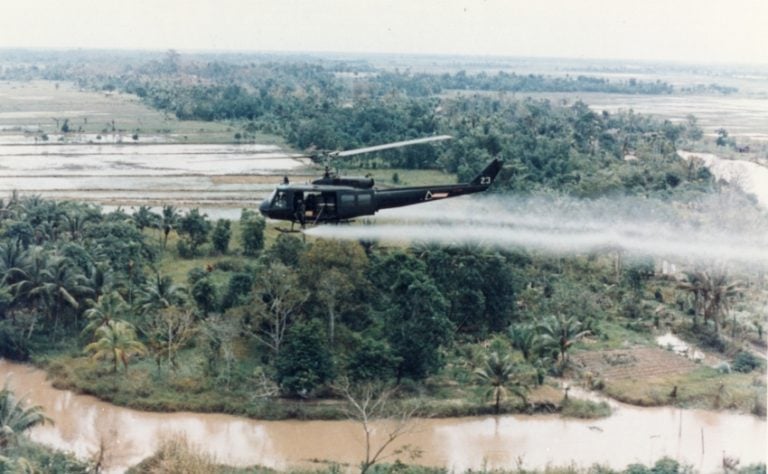

(Photo credit: Admiral Elmo R. Zumwalt, Jr. Collection: Agent Orange; U.S. Army Operations in Vietnam, Huey Defoliation, National Archives. Texas Tech Image Source: https://www.vietnam.ttu.edu/resources/agentorange/images.php)
U.S. troops have fought in jungles since the Spanish-American War. Vietnam, however, presented new challenges, as enemy forces used the thick, triple-canopy jungle as a tactical advantage in guerilla warfare. To counter this advantage, the Americans launched Operation Ranch Hand in 1962, employing chemical herbicides and defoliants in enormous quantities to deprive the enemy of places to hide. Agent Orange is the most infamous of these “rainbow herbicides,” and its lingering toxicity continues to affect those exposed on either side of the conflict.
Overview
The first U.S. combat troops didn’t arrive in Vietnam until March 1965, but by then the effort to defoliate the jungle was well under way. Agent Orange was first sprayed in August 1961. President Kennedy had authorized the use of herbicides in December 1961, and the U.S. Air Force began flying Operation Ranch Hand missions the following month.
Operation Ranch Hand (part of a larger program known as Trail Dust) was designed to defoliate areas used by the enemy as cover for ambushes, as well as to destroy enemy subsistence crops. The chemical weapons used were known as “Rainbow Herbicides” — Agent White, Agent Purple, Agent Blue, Agent Pink, Agent Green, and Agent Orange — named for the colored bands painted on their respective storage drums. Between 1962 and 1971, the U.S. sprayed an estimated 20 million gallons of these herbicides in Vietnam, eastern Laos, and parts of Cambodia, usually from helicopters or low-flying aircraft, but sometimes from backpacks, boats, and trucks.
Agent Orange alone accounted for more than half of the total volume of herbicides deployed. One of its key ingredients, dioxin, is highly toxic even in tiny quantities. Operation Ranch Hand deployed about 375 pounds of dioxin over an area about the size of Massachusetts, contaminating the entire ecosystem and exposing millions of people — on both sides of the conflict — to horrifying long-term effects, including skin diseases and cancers among those exposed, and birth defects in their children.
The ecological, health, and legal issues created by the use of chemical defoliants during the Vietnam War are complex, internationally debated, and continue to the present day. U.S. military personnel who were exposed to Agent Orange while serving in Vietnam have litigated the issue for decades, seeking compensation for medical care resulting from Agent Orange exposure. They have sued both the U.S. government and the corporations who manufactured the chemical compounds.
In 1979, President Jimmy Carter authorized the first Department of Veterans Affairs (VA) study of Agent Orange, to evaluate the effects of the chemical compound on the pilots who sprayed it. The Agent Orange Act was established in 1991. This allows the VA to declare a range of diseases as probable effects of Agent Orange exposure, enabling veterans to pursue services in relation to those diseases.
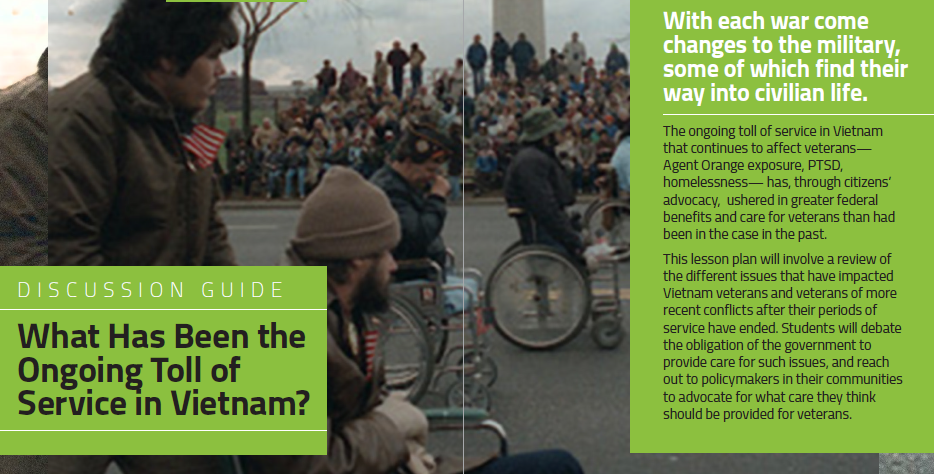

Perhaps the most publicized cause of ongoing health issues in Vietnam veterans is exposure to Agent Orange, which resulted in myriad diseases and birth defects that are carried forward in the children of those exposed. Agent Orange was a chemical compound developed by Dow Chemical to serve as a defoliant—meaning it would kill crops and other vegetation in the areas where sprayed—that would aid in rapidly and effectively clearing areas of the Vietnamese countryside that might provide cover to enemy troops and feed the people. In spite of some initial research that suggested the use of the chemical compound could create health problems for those exposed, the defoliant was used widely in Vietnam. Those who were exposed to Agent Orange may end up developing a range of health problems, including Parkinson’s disease, Hodgkin’s disease, prostate cancer, respiratory cancer, and more. In 1979, President Jimmy Carter authorized the first Department of Veterans Affairs (VA) study of Agent Orange, to evaluate the effects of the chemical compound on the pilots who sprayed it. After a decade of lawsuits filed by veterans for compensation to cover medical treatment needed as a result of Agent Orange exposure, the Agent Orange Act was established in 1991 to allow the VA to declare a range of diseases as probable effects of Agent Orange exposure, and thus veterans could pursue services in relation to those diseases.
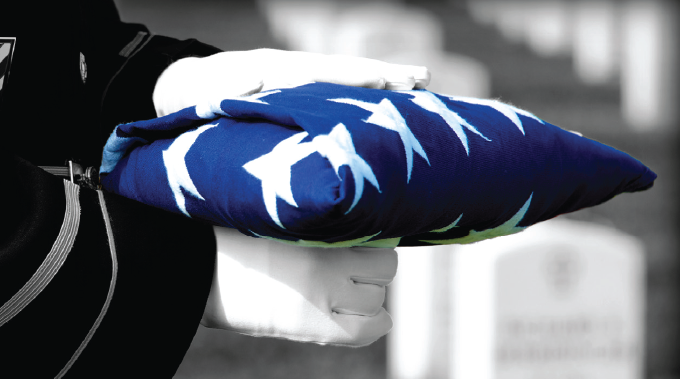

Since the Vietnam War ended, thousands of Vietnam veterans have died each year due to Agent Orange exposure, PTSD/suicide, cancer and other causes related to their service. The Vietnam Veterans Memorial Fund’s (VVMF) In Memory program honors those who returned home from Vietnam and later died.
The plaque on the grounds of the Vietnam Veterans Memorial site in Washington, D.C. that honors these veterans was dedicated in 2004 and reads: In Memory of the men and women who served in the Vietnam War and later died as a result of their service. We honor and remember their sacrifice.
In Memory was created in 1993 by the group – Friends of the Vietnam Veterans Memorial. VVMF began managing the program and hosting the ceremony in 1999. More than 5,000 veterans have been added to the In Memory Honor Roll since the program began. To see all the honorees, please visit the In Memory Honor Roll.
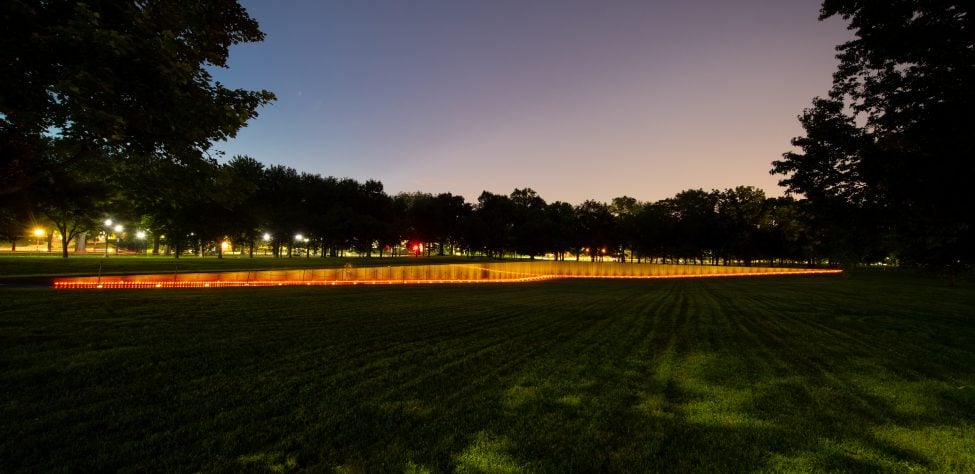

The first use of Agent Orange is thought to have occurred on August 10, 1961. On August 10, 2020, VVMF held its first-ever Agent Orange awareness event. “Bring Light” illuminated the entire Vietnam Veterans Memorial site with orange candlelight — from The Wall itself to The Three Servicemen statue, the flagpole, the Vietnam Women’s Memorial statue and the In Memory plaque.
A huge part of VVMF’s mission is to honor those who served and sacrificed, and many veterans and their families are still suffering from the war’s lingering effects. The goal of “Bring Light” is to raise awareness around the continuing impact of exposure to Agent Orange during the Vietnam War. Those who were exposed have developed a range of health problems, including Parkinson’s disease, Hodgkin’s disease, prostate cancer, respiratory cancer, and more.
In addition to raising awareness for veterans who still struggle with the lasting effects of Agent Orange exposure, “Bring Light” also raises funds in support of ongoing VVMF programs.
Purchase Agent Orange Awareness shirts and sponsor a candle: https://www.vvmf.org/Agent-Orange-Awareness-Day/
For many Vietnam veterans and their families, the fight didn’t end when the war was over. In the years following, many veterans have continued to deal with combat injuries, service-connected illnesses due to Agent Orange exposure, PTSD, and survivor’s guilt. Hear Callie Wright, VVMF’s Director of Education, talk about Agent Orange and its lingering effects while The Wall That Heals exhibit was on display in Marco Island, Florida in February 2020.
Since The Wall was dedicated in 1982, more than 400,000 items have been left by visitors as remembrances and tributes. The National Park Service (NPS) collects, catalogs, and preserves these objects as part of the Vietnam Veterans Memorial collection, with curatorial support from VVMF. The virtual collection includes the curatorial records of a small portion of the items that have been left at The Wall over the years. Some of the items refer to the ongoing struggles of Vietnam veterans and the illnesses and diseases many endured as a result of their exposure to Agent Orange.


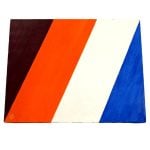

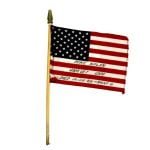

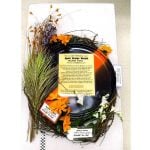

Use the controls below to zoom into the timeline and navigate the dates.


EP10 – Agent Orange
The Vietnam war ended nearly 50 years ago, but thousands of Vietnam veterans and their families are still fighting illnesses related to Agent Orange exposure. On the 60th anniversary of the first use of Agent Orange in Vietnam, we bring you a couple of personal stories from people whose lives are still marked by the use of this deadly toxin.
EPISODE SHOW NOTES
- VVMF Topic Page on Agent Orange – https://www.vvmf.org/topics/Agent-Orange/
- A Permanent Mark: Agent Orange in America and Vietnam (removed from YouTube but the synopsis is available) – https://www.makingchangemedia.com/a-permanent-mark
- VVMF Agent Orange Awareness Day – https://vvmf.org/ao-2021
- The Wall That Heals – https://www.vvmf.org/The-Wall-That-Heals/
- YouTube Echoes of the Vietnam War Interview playlist – https://www.youtube.com/playlist?list=PLK63b6Cn53unMMj-yZYEch0RuYy1YN1zl
- VIDEO: “Agent Orange” — History.com
- VIDEO: “The Dark Shadow of Agent Orange” — The New York Times
- VIDEO: “The Vietnam War’s Agent Orange Legacy” — Unreported World
- VIDEO: “Vietnam Soldiers Still Suffer From Agent Orange” — Vietnam Reporting Project
- VIDEO: “Veterans’ Benefits for Agent Orange Exposure Expanded” — WNYC
- “Agent Orange During the Vietnam War And Its Effects Today” — VVMF Blog
- “Agent Orange exposure” — U.S. Department of Veterans Affairs, Disability benefits
- “Agent Orange” — Encyclopaedia Britannica
- “Jungle Warfare” — Encyclopedia.com
- “The Military Use of Herbicides in Vietnam” — Veterans and Agent Orange: Health Effects of Herbicides Used in Vietnam
- The VVA Self-Help Guide to Service-Connected Disability Compensation For Exposure To Agent Orange for Veterans and Their Families — Vietnam Veterans of America (VVA)
- VVA Brochure: Has Your Child or Grandchild’s Health Been Affected by Your Military Service? — Vietnam Veterans of America (VVA)

